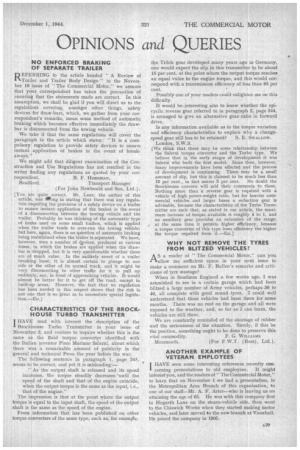CHARACTERISTICS OF THE -BROCK HOUSE TURBO TRANSMITTER
Page 31

If you've noticed an error in this article please click here to report it so we can fix it.
I HAVE read with interest the description of the Brockhouse Turbo Transmitter in your issue of November 3, and venture to inquire whether this is the
same as the fluid torque converter identified with the Italian inventor Piero Mariano Salem', about which there was a remarkable amount of publicity in the general and technical Press the year before the war.
The following sentence in paragraph 1, page 245, seems to be correct, and yet it is misleading:—
" As the output shaft is released and its speed increases, the torque steadily decreases 'until the speed of the shaft and that of the engine coincide, when the output torque is the same as the input, i.e., that of the engine."
The impression is that at the point where the output torque is equal to the input shaft, the speed of the output shaft is the same as the speed of the engine.
From information that has been published on other torque converters of the same type, such as, for examitle, the Trilok gear developed many years ago in Germany,
one would expect the slip in this transmitter to be about 15 per cent, at the point where the output torque reaches an equal value to the engine torque, and this would cor respond with a transmission efficiency of less than 85 per cent.
Possibly one of your readers could enlighten me on this difficulty.
It would be .interesting also to know whether the epicyclic reverse gear referred to in paragraph 2, page 244, is arranged to give an alternative gear -ratio in forward drive.
Is any information available as to the torque variation and efficiency characteristics to explain why a change
speed gear still has to be retained? S. E. SWALLOW. London, S.W.3.
[We think that there may be some relationship between the Salerni torque converter and the Turbo type. We believe that in the early stages of development it was Salerni who built the first model: Since then, however,' Many improvements have been effected and the process of development is continuing. There may be a small amount of slip, but this is claimed to be much less than 15 per cent., in fact nearer 5 per cent. No doubt the Brockhouse concern will add their comments to these. Nothing more than a reverse gear is required with a vehicle of high power-weight ratio, but for heavier commercial vehicles and larger buses a reduction gear is advisable, because the characteristics of the Turbo Transmitter are such that, as stated in our article, the maximum increase of torque available is roughly 4 to 1, and an auxiliary gear provides an extension of the range;
.,, at the same time it permits higher efficiency, because a torque converter of this type loses efficiency the higher the torque required from it.—ED.]




















































